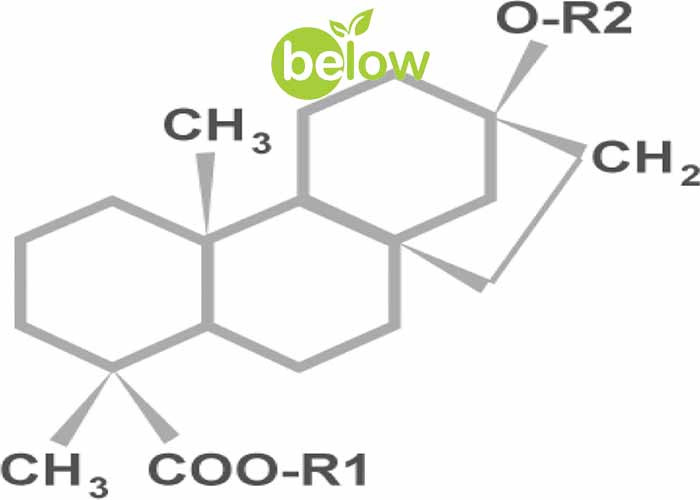Your cart is currently empty!
Stevia sugar compounds, extracted from the leaves of the Stevia plant, are used as a natural sweetener in many food products and beverages. The main components of stevia include steviol glycosides, which create a sweet taste without adding calories or extra sugar to the body. These compounds mainly consist of stevioside, steviol, and steviol glycoside, whose sweetness ranges from 50 to 300 times that of regular sugar. Due to these unique properties, stevia is introduced as a suitable alternative to sugar in low-calorie and diabetic diets.
Stevia Sugar Compounds in Traditional Medicine
Since ancient times, stevia has been used in traditional medicine to treat some health problems. In traditional medicine, stevia has been utilized to reduce blood pressure, control blood sugar, and even as a treatment for digestive issues. Some researchers believe stevia may also have anti-inflammatory and antibacterial effects and can be beneficial in treating diseases such as joint inflammation. Additionally, consumption of stevia is highly recommended in traditional medicine for diabetics, as it does not cause negative changes in blood sugar levels.
Structure of Stevia
Stevia is a plant from the Cassia family, native to South America. The chemical structure of stevia includes steviol glycosides, which are responsible for its sweet taste. These compounds exist naturally in the leaves of stevia and are separated from other substances during the extraction process. Because stevia contains calorie-free sweetening compounds, it is recognized as an excellent option for those seeking weight loss or blood sugar control. Moreover, the molecular structure of stevia means it is not easily digested in the human body and does not negatively affect metabolism.
Chemical Compounds of Stevia Sugar: Steviol Glycosides
This section focuses on the main chemical compounds of stevia. The most important are steviol glycosides, which create a natural sweet taste without adding calories or sugar to the body. These compounds include steviol, stevioside, and steviol glycoside, which are 50 to 300 times sweeter than sugar. Due to these unique compounds, stevia has become a healthy choice for diabetic and low-calorie diets. Additionally, steviol glycosides do not harm teeth and unlike sugar, do not cause tooth decay. These chemical properties have made stevia accepted as a natural and healthy sweetener in many countries worldwide.
Steviol Glycosides and Their Effect on Sweetness
The steviol glycosides found in stevia are responsible for creating its sweet taste. These compounds act without increasing blood glucose levels and directly affect taste receptors on the tongue. This section explores how these compounds can produce a sweetness similar to sugar, without any negative health effects. However, some people may initially notice a distinct taste of stevia that differs from sugar’s sweetness. Over time, most people get used to this taste and benefit from stevia’s positive features. Furthermore, steviol glycosides do not negatively impact digestion and are easy to digest.
Mechanism of Stevia’s Effect
Stevia’s mechanism of action mainly relates to its glycoside compounds. These compounds bind to taste receptors on the tongue, sending a sweet taste signal to the brain without any adverse effect on blood glucose levels. For this reason, stevia is suitable for diabetics and those aiming to reduce calorie and sugar intake. Some studies also suggest stevia consumption may help lower blood pressure due to its positive cardiovascular effects. Thus, stevia is a natural choice for people seeking to improve overall health.
Extraction and Processing of Stevia Compounds
Stevia is extracted from the leaves of the stevia plant, but to be used in the food industry, these compounds must be separated and purified. This section explains the various extraction methods of steviol glycosides from stevia leaves and their processing to produce stevia sweeteners. These processes preserve the sweet properties of stevia under different cooking conditions. Extraction is usually done by natural methods without chemicals, maintaining the natural health benefits of stevia. Ultimately, processing allows stevia to be easily used in various food products, beverages, and supplements.
Comparison of Stevia Compounds with Other Natural Sweeteners
This section compares stevia with other natural sweeteners such as honey, date sugar, and maple syrup. Unlike many of these sweeteners, stevia contains no calories and does not raise blood sugar levels. Meanwhile, other sweeteners may rapidly increase blood glucose, potentially leading to diabetes. Therefore, stevia is a healthier choice for those wanting to reduce sugar and calorie intake. Moreover, stevia has stronger anti-inflammatory and antioxidant effects than many of these sweeteners, which benefits overall health. Using stevia instead of sugar can also reduce the risk of heart disease and high blood pressure.
Effects of Stevia Compounds on Overall Health
Stevia’s compounds, due to their anti-inflammatory and antioxidant properties, can improve overall health. This natural sweetener can strengthen the immune system and help reduce blood pressure and diabetes. This section reviews the positive and negative effects of stevia compounds on health and their use in treating certain diseases. Some studies indicate that stevia consumption may reduce the risk of heart disease, stroke, and some cancers. Additionally, stevia can reduce oxidative stress and chronic inflammation, which are main causes of various diseases.
Benefits of Using Stevia in Food Products
Using stevia in the food industry has many benefits. This natural sweetener is calorie-free and is used in producing sugar-free, diet, and low-calorie products. This section discusses how stevia helps reduce sugar and calorie intake in foods and beverages, benefiting those pursuing healthy diets. Stevia is particularly useful in producing low-calorie and sugar-free products for diabetics and obese individuals. It also enables products to have a sweet taste similar to sugar without negative health effects.
Stability of Stevia Compounds at High Temperatures
One notable feature of stevia is the stability of its sweetening compounds at high temperatures. This makes stevia suitable for cooking and baking without losing sweetness. This section examines the heat stability of stevia compounds and their applications in desserts and hot beverages. This feature makes stevia an ideal choice for the food industry, which requires sweetened products. Some experts believe this heat stability can also reduce costs in food and beverage production.
Benefits of Stevia Use in Food Products
Effect of Stevia Compounds on Blood Sugar Control
Stevia, due to its glycoside compounds, has no direct effect on blood sugar levels and can be safely used as a sugar substitute in diabetic diets. This section reviews research showing that stevia consumption can improve insulin sensitivity and blood sugar control in people with type 2 diabetes. Studies also show that stevia may reduce chronic inflammation and improve pancreatic function, which is beneficial in diabetes control. Moreover, stevia consumption can prevent blood sugar fluctuations, maintaining stable energy levels throughout the day.
Conclusion: Stevia Sugar Compounds
Stevia sugar compounds, with their unique properties as a natural, calorie-free sweetener, are a suitable option for those seeking to reduce sugar and calorie intake. Its use in traditional medicine, chemical structure, and mechanism of action all contribute to making stevia a popular choice, especially for diabetics and those aiming for weight loss. Considering stevia’s numerous benefits, this sweetener can improve health and safety while attention to safety precautions is recommended for long-term consumption.


Leave a Reply